![[MetroActive Music]](http://metroactive.com/music/gifs/music468.gif)
[ Music Index | SF Metropolitan | MetroActive Central | Archives ]
Straight Ahead
The New Generation of
By Amanda Nowinski
It's simple to spot the music heads in a crowd--they're the ones who aren't talking. Unlike relentless mouths, heads know to applaud at the end of a musician's solo, to not wander in front of the band. Most importantly, they know when to turn their cell phones off.
Armed with mighty vocal chords and a kinetic stage presence, Ledisi and her band Anibade unwittingly command a domination of heads on this particular night. It is nearly midnight at Rasselas, and the band is far beyond warmed up. As the singer flows into a smoky rendition of "Summertime," the ubiquitous chatter transforms into silent curiosity, forcing a table of Prada-toting debutantes to begrudgingly strain their necks toward the stage. Unfortunately for those who believe that the primary use of jazz is to fill lapses in dinner conversation and barroom giggles, Ledisi proves that a jazz club's greatest stimulus normally emanates from the band. Indeed, tonight is a rare victory for the heads over the flapping lips.
Tap, teh tap tap ... Drummer Brian Collier builds a syncopated foundation before Sundra Manning jumps in, her fingers releasing a fervent spirit from the unassuming baby grand. Victor Little extrapolates from his electric bass, providing just the right groove for what Ledisi is about to do: scat like a madwoman. Decked out in overalls and a tomboy cap, the untraditional diva twists her body, bends her knees, flares her arms, does anything it takes to unleash that magnanimous sound. The group bursts into a wildly contained improvisation, and like rest of the audience, I am struck by this consummate expression of jazz.
Now representing the third-largest jazz consumer market in America, San Francisco has, unsurprisingly, grown into a breeding ground for new jazz talent. Ledisi, Robert Stewart, Kenny Brooks, Marcus Shelby, Graham Connah--these are just a few of the freshest sounds rising. Enabled by the city's frenzied increase in its supply of restaurants and nightclubs, young jazz musicians in San Francisco now have more opportunities than in the 1960s to find respectable gigs.
"That's the one thing that's really good about this area," explains Brooks, a saxophonist who plays with drumming legend Eddy Marshall and recorded the album Natty Dread on Blue Note with former San Franciscan Charlie Hunter. "There are a lot of places to play; places fold up and others pop up right away, so it's usually pretty constant work."
In a city obsessed with hip dining experiences, restaurant owners have wised up to the addition of live jazz, a feature which is no longer confined to only the most exclusive establishments. Enrico's, Bruno's, Rasselas, Moonshine and 42 Degrees all provide diners with top-notch music seven nights a week. "No one's afraid of going out of business," says pianist and avant-garde composer Graham Connah. "Therefore, they're willing to spend money on musicians."
Although many clubs, such as the Elbo Room, the Up & Down Club and the Red Devil Lounge, alternate jazz bookings with other styles, only the Black Cat's Blue Room and Pearl's promote jazz exclusively. "It's a very exciting time right now," says Blue Room manager Lawrence Robinson. "There are a lot of young players who are pushing the envelope, listening to the classics, and taking the kinds of risks that musicians took in the '30s when the genre hadn't fully developed. There's more than enough young talent from the Bay Area, which enables us to remain loyal to the local community."
The consistency of live exposure has propelled many San Francisco artists to the next level of the music industry: studio recording. Ledisi, who received a standing ovation for her performance at last year's Monterey Jazz Festival, will self-release a new CD later this month and is currently teaming up with bassist Marcus Shelby to record an album on his Noir Records label. "I'm not worried about being discovered by a big label, but it is good to produce. But more importantly, I think my role in San Francisco is to invent a new sound, to be different, not be your regular singer that just stands there being cute. We're aching for new standards and new straight-ahead sounds."
A uniquely gifted tenor saxophonist and flutist who picked up the instrument for the first time while a senior in high school, Robert Stewart, 29, is taking the upper-crust jazz market by storm. Discovered by an A&R rep from Quincy Jones' Qwest while gigging at Pier 23 three years ago, Stewart has since produced two solo albums with the label. Appearing with Wynton Marsalis on two Jazz at Lincoln Center albums (Columbia), Stewart has played with an incredible list of heavyweights, including Dizzy Gillespie, Max Roach, Donald Byrd and McCoy Tyner.
"I've been really lucky," Stewart says.
But the type of A&R break that launched Stewart's recording career is uncommon in San Francisco, a city whose music industry presence is far behind New York and Los Angeles. Surprisingly, few local musicians find this discouraging. "The kind of music I do isn't really marketable by big labels anyway," Connah says. "I'm not interested in that. I didn't get involved in jazz to become popular or famous; I just got involved in jazz because I'm a creative person. The thing about jazz," he continues, "is that major labels are interested in it, and then suddenly they're not. We're in a cycle right now where younger musicians are having relationships with major labels, but that tends to come and go because the record companies can't really make money on jazz. Ultimately you're dealing with artists that might sell a couple thousand records, which is nothing in the world of the music business. So I'm drawing a distinction between the music business and music itself."
Unlike fame-obsessed pop musicians, the jazz player operates in a very different reality: "Very few people get discovered in the sense that you're going to be a 'jazz star,' " Brooks says. "In jazz, you never think about it in terms of making it big. No, no. It is kind of hard, but what we're doing here is something very creative and that appeals to a limited audience. [The creativity] keeps us going."
Nonetheless, it makes perfect sense that many young Bay Area jazz musicians eventually leave for New York. Joshua Redmon defected not long ago, as did Liberty Ellman, Charlie Hunter and Vijay Iyer--all vital players from the San Francisco scene. In addition to being closer to the industry, New York's numerous high-end jazz venues provide younger musicians with the opportunity to sit in with the greats and thereby establish the sort of contacts that might radically improve their career. With only one international jazz venue in the Bay Area--Yoshi's--and a handful of independent labels, San Francisco lacks the infrastructure to support a fully operational jazz environment.
With four solo albums and more than 20 CD appearances under his belt, pianist Dred Scott is ready to make the East Coast move. "I'm very well-established here, and everyone seems to dig what I'm doing, but there's a ceiling," he explains. "There are only a few clubs that will take you into the house-buying zone. By going to New York, you're in a position where more people will see you, and it's more conducive to traveling the world and hooking up with labels."
Even the older players in San Francisco insist that a jazz musician can't fully mature unless he spends time in New York. "New York has always been the center of jazz, and it probably always will be," confirms San Francisco piano virtuoso Mark Levine. "So when musicians reach a certain level, they go to New York. The presumption is that it's the industry that's the driving force; but the truth is, you go there because the best players are there. And that's how you learn--you want to get your butt kicked and get even better." A native of New Hampshire, Levine travels the international jazz circuit regularly and has performed with Chet Baker, Poncho Sanchez, Stan Getz, Eddie Marshall and Woody Shaw. "I hate to be discouraging," he adds, "but it's just like the art scene--if you're serious, you go to New York."
With the $35 million Fillmore Renaissance Project scheduled for next year, San Francisco will have its first international jazz venue since the closing of the Keystone in the mid-'80s. The Tokyo-owned Blue Note, whose club headquarters are in New York, will be part of the mayor's ambitious plan to re-establish the jazz tradition of the Western Addition. It is doubtful, however, that the corporate venue will compare to Jimbo's Bop City, the infamous after-hours club on Post that hosted everyone from Charlie Parker to Miles Davis in the late '40s to the mid '60s. To be housed on the ground level of the six-level Fillmore Renaissance multiplex, Blue Note will share space with some very unjazzy counterparts: a parking garage and an AMC theater.
Naturally, the locals are suspicious of the inorganic project. "I'll believe it when I see it," Levine says. Jazz critic and documentary filmmaker Andy Gilbert is equally skeptical. "I don't have much hope," he explains. "The Blue Note's booking in New York is pretty mainstream and boring. In fact, of all the major clubs in New York, they always book the least interesting acts. Although any full-time jazz club in San Francisco is an improvement, from what I hear, Blue Note isn't looking to book locals anyway, and the people they're bringing in are not going to be the people that Bay Area jazz fans will be interested in seeing. The Blue Note is not likely to provide the opportunity for younger musicians to play with the greats. If the greats do in fact come, they will probably bring their own rhythm sections. No, the Blue Note will not make a significant contribution."
What, then, will cause an awakening shift in the state of San Francisco jazz? "San Francisco needs local institutions to support its jazz scene," says Ted Gioia, author of the seminal historical text West Coast Jazz. "The single biggest contributor to the growth of modern jazz in San Francisco in the 1950s was the presence of one important record company, Fantasy, that was willing to back the homegrown talent. Without record labels, clubs and local media attention, the local jazz scene cannot thrive."
As many an old-timer will let you know, San Francisco in the '50s and '60s was like Paris in the '20s--only 10 times nuttier. Native talents like Dave Brubeck and Cal Tjader shared the stage with the visiting founders of modern jazz--Miles Davis, Charlie Parker, Charles Mingus, Gerry Mulligan, the Modern Jazz Quartet, John Coltrane--at clubs like the Blackhawk on Hyde and the Jazz Workshop on Broadway. North Beach, the Tenderloin, the Fillmore, downtown and even Chinatown had their own intimate, jazz-exclusive clubs. The unifying club, however, was Jimbo's Bop City, where everyone piled in after last call.
"Bop City went from 2 to 6am," explains poet ruth weiss, who is credited with combining jazz and poetry in the 1950s North Beach bohemia. A progressive scene where blacks and whites commingled, the bebop explosion in San Francisco paved the way for the free-loving spirit of the hippie generation. "It was a really wild scene," weiss reminisces. "Jimbo hired me to waitress at Bop City because I didn't have any money to get in. They used to charge a dollar--which was a lot of money in the '50s. 'You haven't got a dollar? This is a business!' shouted Jimbo to me one night. So he hired me and said, 'Listen, grab a tray. There's no wages, but there's tips. And we sell only near-beer, you hear?' Because Jimbo's was after-hours, we couldn't sell beer--but we did sell near beer."
"In the '50s and '60s, people really listened to the music," San Francisco native Tad Sekino says. "Jazz is the kind of music that you really have to listen to to understand--you have to follow the structure to understand the improvisation." The architect of some of the city's larger venues, Slim's and Storyville (which no longer follows a jazz format), Sekino misses the intimacy of the earlier years. "The clubs, even the Blackhawk and the Workshop, were pretty small--about the size of the CoCo Club. You really felt close to what the musicians were creating. This creates excitement among the crowd--but to begin with, you have to like the mystery of creative music to appreciate jazz."
Although the San Francisco jazz scene died in the late '60s when rock, and later fusion, took over, that the clubs survived for more than a decade in a town that now has only two jazz-exclusive venues is quite remarkable. "The reason that jazz survived that era is because the small clubs could afford great musicians--their fees were low because most of the players were still fairly unknown," Sekino continues. "Now the only place to hear music like that is Yoshi's or the Jazz Festival--and both completely lack the intimacy of the old days."
Damned by the lack of both space and money, local club owners cannot afford to bring out the heavies, which can run up to $17,000 for a big-name quartet. "No one in San Francisco but the Blue Note will be able to afford that," jazz writer and photographer Mars Breslow says. "And even they might not make a profit. They may sell out Friday and Saturday, but what about the rest of the week? This is the main reason big-name musicians only come to Yoshi's and the Jazz Festival."
Even if larger clubs were to open in San Francisco, it is unlikely that the young audience would fork over the cash for a $15 cover and a two-drink minimum, which is the standard at New York clubs like the Vanguard, Birdland and Iridium. "Young kids spend that much on beer and toys--why not spend it on someplace like Yoshi's, where you're going to get a real jazz education?" Breslow demands.
"Most jazz venues here put food first and music second," he continues. "The restaurant manager doesn't want the dynamic of the music to interrupt conversation--which goes to show that that is not a real jazz club. And even at the bars that play jazz, young people don't really listen to the music. They're there for the ambiance because it's hip for them to be there. They're not listening, they're talking. It's all young white kids in their 20s. Where are all the black people? Where are all the older people?"
The young musicians are not unaware of the general audience's irreverent behavior. "I do get frustrated with people talking during my sets," Ledisi says. "But if I really paid attention it, I'd be a dead woman. That's what I liked about the Monterey Jazz Festival--people really listened."
"Most of the times we're playing in situations that are not ideal," Connah says. "But if we're lucky, we can barely scrape a living doing it. If you're really focused on your music, it can be a very creative experience. The music is creative, so the musicians focus on one another and have as much fun as they can, despite the fact that they might be in a room full of people talking and blowing smoke in their faces. But the music gets you through. I've gone through years of playing in really heinous environments, but the music keeps it happening for me."
Establishing the stream of consistent restaurant gigs, it appears, is the key to a young jazz musician's survival in San Francisco. But while the city has yet to evolve into a New York, it would be nice to see a few immediate improvements, especially when it comes to giving our players respect. After all, if we don't take the time to put down the chardonnay, shut our busy traps and focus our eyes onstage, a vital sound might evade us ...
[ San Francisco | MetroActive Central | Archives ]
Copyright © Metro Publishing Inc. Maintained by Boulevards New Media.
![]()
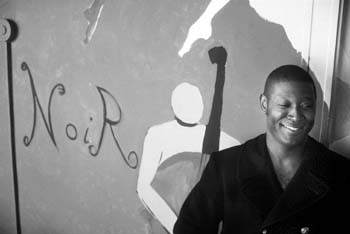
Jazz Noir: Marcus Shelby, 30, is teaming up with local jazz innovators like Ledisi on his Noir Records label.
Jazz in San Francisco
Photos by Farika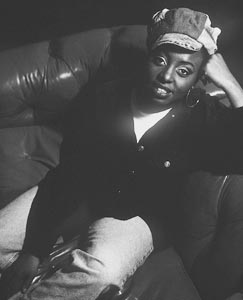 Scat Scratch Fever: Vocalist Ledisi holds the attention of even the most dedicated chardonnay sippers.
Scat Scratch Fever: Vocalist Ledisi holds the attention of even the most dedicated chardonnay sippers.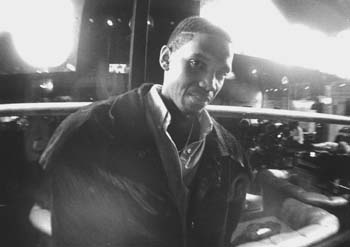
You Can Get There From Here: San Francisco may lack a jazz infrastructure, but it is a fertile breeding ground for new talent.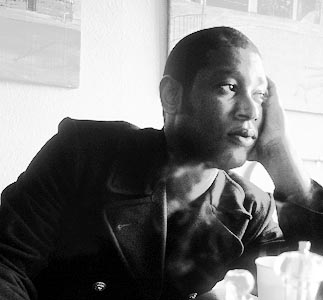
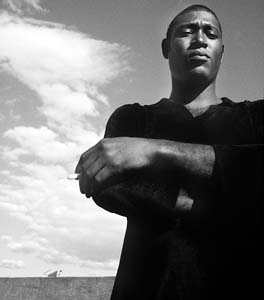 The Sky's the Limit: SF local Marcus Shelby has gained national notice.
The Sky's the Limit: SF local Marcus Shelby has gained national notice.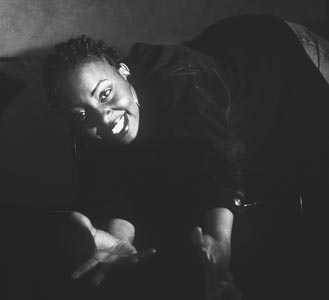
Asking for Attention: 'I do get frustrated with people talking during my sets,' Ledisi says.
From the March 29, 1999 issue of the Metropolitan.